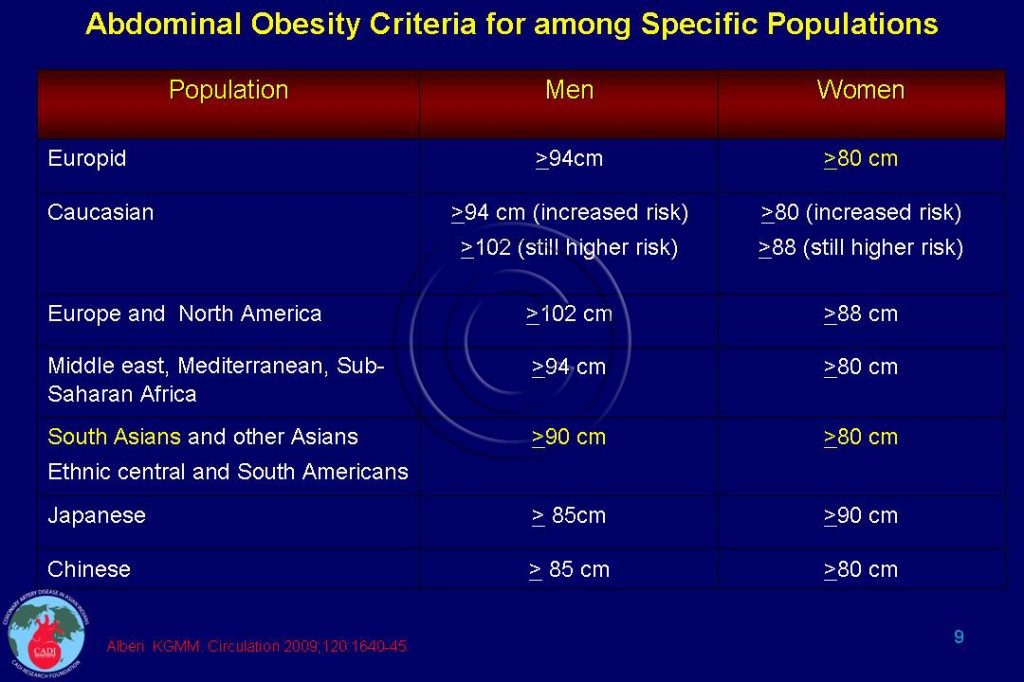Abdominal Obesity Criteria
- Waist hip ratio (WHR) is considered a better measure of abdominal obesity because it also takes into consideration the harmful effects of visceral fat and protective effect of gluteal fat.
- Since the excess fat is usually concentrated in the hip in women and the waist in men, the optimum value of WHR is lower in women (<0.85) than in men (<0.95).1
- Although more accurate, WHR is difficult to measure accurately and communicate effectively especially to the obese. Besides, measurements of hip circumference are socially awkward and not acceptable in many societies, particularly women, many of whom may object to measuring their butts.
- A waist to height ratio is easy and cheap to measure and is closely linked to cardiovascular disease (CVD), hypertension, dyslipidemia and diabetes.2 A ratio of 0.5 appears to be the optimal cut point in both sexes and different ethnicities including children.2-5 It is also easy to memorize and can be used effectively in public health campaigns since height is always recorded in research studies.
- Several studies have found waist circumference (WC) to be a good measure of central obesity (belly fat) and cardiometabolic risk.6 2 WC is easy to measure using an inexpensive tape and is more accurately understood as concept of obesity than anthropometric ratios.2
- In recognition of the heightened risk at lower WC in Asians, the World Health Organization and International Diabetes Federation have endorsed specific lower WC for Asians for more than 10 years.7
- In 2009, in an unprecedented effort to harmonize the definition of metabolic syndrome, several national and international organizations came together and published joint statement for WC. The signatories include the International Diabetes Federation; National Heart, Lung, and Blood Institute; American Heart Association; World Heart Federation; International Atherosclerosis Society; and international association for the Study of Obesity; and the International Diabetes Federation.8 The statement provides ethnic specific, country specific, and gender specific cutpoints (Table 009).8
- Its worth noting that the WC cut point for the diagnosis of abdominal obesity is >90cm for Asian Indian men and as opposed to >102cm for Europid men. The respective cut points are >80 cm for Asian Indian women and 88cm for Europid women. These values are about 8-12 cm lower than that recommended for Americans and underscore the need for early institution of weight management programs in Asians.9
Sources
1. Rexrode KM, Carey VJ, Hennekens CH, et al. Abdominal adiposity and coronary heart disease in women. JAMA. 1998;280(21):1843-1848.
2. Tseng CH, Chong CK, Chan TT, et al. Optimal anthropometric factor cutoffs for hyperglycemia, hypertension and dyslipidemia for the Taiwanese population. Atherosclerosis. Jun 2010;210(2):585-589.
3. Ashwell M, Hsieh SD. Six reasons why the waist-to-height ratio is a rapid and effective global indicator for health risks of obesity and how its use could simplify the international public health message on obesity. Int J Food Sci Nutr. Aug 2005;56(5):303-307.
4. Ho SY, Lam TH, Janus ED. Waist to stature ratio is more strongly associated with cardiovascular risk factors than other simple anthropometric indices. Annals of epidemiology. Nov 2003;13(10):683-691.
5. Hsieh S D, Yoshinaga H, Muto T. Waist-to-height ratio, a simple and practical index for assessing central fat distribution and metabolic risk in Japanese men and women. Int J Obes Relat Metab Disord. May 2003;27(5):610-616.
6. Despres JP. Health consequences of visceral obesity. Annals of medicine. Nov 2001;33(8):534-541.
7. Asia Pacific Perspective:Redefing obesity and its treatmentf World Health Organization, Western Pacific Region;2000.
8. Alberti KG, Eckel RH, Grundy SM, et al. Harmonizing the metabolic syndrome: a joint interim statement of the International Diabetes Federation Task Force on Epidemiology and Prevention; National Heart, Lung, and Blood Institute; American Heart Association; World Heart Federation; International Atherosclerosis Society; and international association for the Study of Obesity. Circulation. Oct 20 2009;120(16):1640-1645.
9. Lemieux I, Pascot A, Couillard C, et al. Hypertriglyceridemic waist: A marker of the atherogenic metabolic triad (hyperinsulinemia; hyperapolipoprotein B; small, dense LDL) in men? Circulation. 2000;102(2):179-184.


